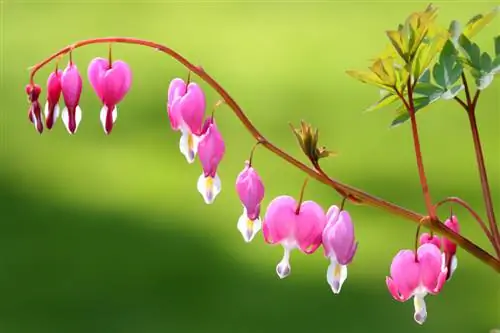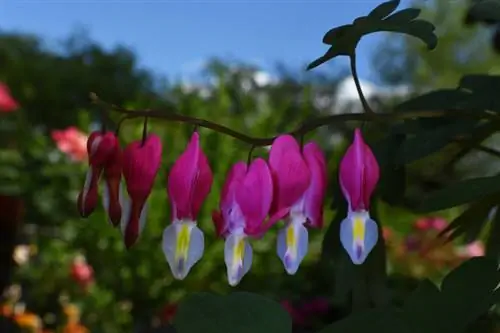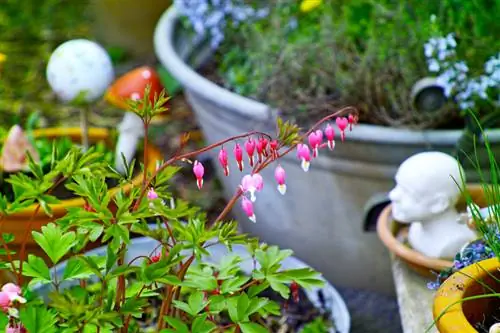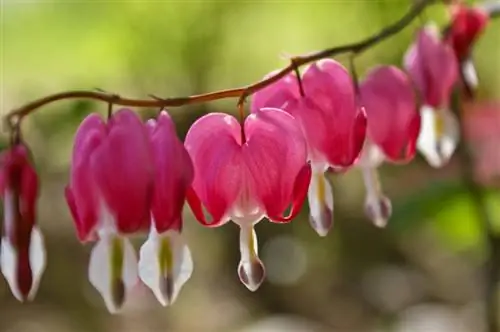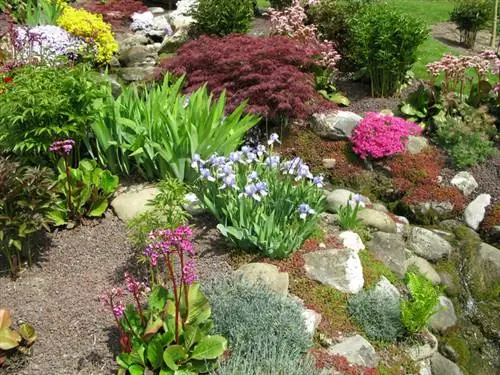- Author admin [email protected].
- Public 2023-12-25 17:45.
- Last modified 2025-01-23 11:22.
The ideal flower for a romantic cottage garden atmosphere enchants with pink and white heart-shaped flowers in spring. Bleeding heart adorns the bed with gracefully curved flower stalks in the light shade. Read here what else the nostalgic plant wants for a magnificent flower.
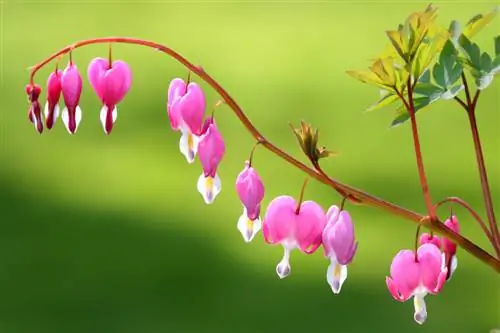
How do you care for a bleeding heart in the garden?
The bleeding heart is a romantic-looking plant that impresses with pink and white heart-shaped flowers in spring. A sunny to partially shaded location with fresh, moist and nutrient-rich soil is ideal. Planting in autumn allows for magnificent flowering the following May.
Planting a bleeding heart correctly
Spring-flowering perennials are ideally planted in autumn. If Bleeding Heart goes into the ground between the end of August and the beginning/mid-October, you can look forward to the first blossoms as early as next May. The flower thrives in a sunny to partially shaded location with fresh, moist and nutrient-rich soil. Place the potted young plant with the root ball in water while you weed and rake the bed. The steps continue:
- The planting pit is twice deeper and wider than the root ball
- In moist soil, drainage made of pottery shards prevents harmful waterlogging
- Enrich the excavated soil with compost (€12.00 on Amazon), horn shavings, sand and rock dust
- Plant the flower up to the lower pair of leaves and water generously
It is good for the moisture-loving flower if it is mulched with leaves or bark mulch after planting. The procedure is similar in the pot, although in this case drainage over the water outlet is mandatory.read more
Care tips
As if the plant were aware that its flowering period falls during the busiest time for the hobby gardener, it contents itself with the following care program:
- A starter fertilization in May with compost and horn shavings in the bed
- In the pot, fertilize liquidly every 2 weeks at half the concentration
- Cleaning up wilted flowers
- Cut back close to the ground when the leaves have drawn in
- If it is dry, water directly onto the roots with normal water
In exposed locations, cover Bleeding Heart with leaves and brushwood before the first frost. In the planter, the flower moves to its frost-free winter quarters. If late ground frost threatens in spring, an upturned flower pot wrapped in fleece will protect the sprouting plant from frostbite.read more
Which location is suitable?
A bleeding heart reaches its optimum in the light shade and protection of deciduous trees. Blazing sun affects the flowers so much that it brings tears to the gardener's eyes. Where sufficient soil moisture is ensured, the flower tolerates a sunny location as long as it is protected from midday sun. A location protected from the wind is just as important for a harmonious silhouette, as the delicate flower stalks are quite fragile.read more
The correct planting distance
So that the flower shows off its grace to perfection, a planting distance of 70 cm is a good choice. There should not be more than 2 copies per square meter. Plant miniature varieties in the soil at a slightly smaller distance of 30 cm. The curved flower stalks of this elegant plant should not touch each other as an effective prevention against fungal infections.
What soil does the plant need?
If you choose a soil with the following criteria for the romantic cottage garden plant, it will feel right at home:
- Fresh, moist and well-drained
- Rich in nutrients and with vital soil life
- A neutral to slightly alkaline pH value
In the balcony box or bucket, the flower prefers a loose compost-based potting soil, optimized with sand, perlite and some rock dust.
What is the best time to plant?
The best time to plant a spring-flowering perennial is autumn, when the soil is still warm from the sun in the months of August to October. By the time winter arrives, the flower has become well established in the location. A bleeding heart starts the next season with a vital growth lead that culminates in a pompous abundance of flowers.read more
When is flowering time?
As a classic spring bloomer, the plant delights us from May to June with its enchanting, pink-white heart-shaped flowers. Cultivars with pure white flowers even last into July. If you clean out the withered flowers regularly, the idyllic bloom will last throughout the entire flowering period.read more
Cut a bleeding heart correctly
After an abundant spring bloom, the flower quickly fades away at the beginning of summer. Since the withered flowers and leaves quickly become unsightly, cut the parts of the plant down to just above the ground. Please do not forget to wear protective gloves when carrying out this work, as the poisonous content of this plant can cause unpleasant skin irritations.read more
Watering a bleeding heart
An alternately moist soil, neither dry nor waterlogged, has a revitalizing effect on an opulent bloom. Water regularly directly onto the root area and avoid overhead watering of the distinctive plant. The water requirement is higher in the pot than in the bed, so the substrate should be checked daily, especially in sunny locations. You can safely use normal tap water as irrigation water.
Fertilize a bleeding heart properly
In terms of nutrient requirements, the flower is undemanding and frugal. In the bed, the plant is content with a portion of compost and horn shavings in May. In the limited substrate volume of the planter, we recommend administering highly diluted liquid fertilizer every 14 days from May to June.
Pests
The roots of a lady's flower are very popular with voles. The pests don't care much about the poison content. To prevent pests from feasting on the plant, plant a bleeding heart in a close-meshed vole basket in vulnerable beds.
Wintering
The plant is completely hardy and can easily withstand temperatures down to -23 degrees Celsius. However, problems can arise if early sprouting is threatened by delayed ground frosts. In rough locations and for a bleeding heart in the pot, we therefore recommend the following precautions:
- Hill up the plant in winter with leaves, brushwood or compost
- If the ground is frosty in spring, place a flower pot over the emerging flower and wrap it with fleece
- Alternatively, spread a garden fleece over the bed at night
Cut back a potted Mary's flower in the fall and move the plant to a frost-free winter quarters. This ensures that the root ball does not freeze. Water the perennial during the cold season so that it does not dry out completely.read more
Multiply bleeding heart
Dividing the roots is an uncomplicated method for propagation. Dig up the plant in spring or autumn and shake off the soil. On a stable surface, cut the root ball into two or more parts, each of which should have at least two shoots. Planted in the new location, you can look forward to the first flowers next spring.
Propagation from cuttings is an alternative to division. In May or June, cut non-flowering head cuttings 10-15 cm long for cultivation in pots with a poor substrate. Since the shoots of this flower are a little brittle, a small stick is used to stabilize them. By autumn, a vital root system will develop on the cutting, so that you can plant the young plant in beds and containers.read more
How do I transplant correctly?
The plant tolerates a change of location without any problems. Ideally, you should replant a bleeding heart in the fall, after pruning. If you choose a date in spring, this year's flowers will usually not bloom. The actual process of this measure is completely uncomplicated. Dig up the root ball over a large area and plant it in the ground at the new location, maintaining the previous planting depth. By the way, transplanting is an excellent opportunity to propagate or rejuvenate the flower through division. As long as at least 2 eyes remain on a segment, the plant will sprout again willingly.read more
bleeding heart in the pot
On the half-shaded balcony, bleeding heart in the pot creates a picturesque idyll if you give the flower the following care:
- Test the substrate daily with a thumb sample in order to water in dry conditions
- Administer a diluted liquid fertilizer for flowering plants every 14 days in May and June
- Clean up wilted flowers regularly
- Repot every 1-2 years
After the foliage has completely retreated in summer, cut the plant down to just above the ground. A bleeding heart spends the winter in a frost-free room in order to move to the balcony in time after the last frosts on the ground.
Is Bleeding Heart poisonous?
Botanists attribute a bleeding heart to the poppy family, which indicates a toxic content that is harmful to he alth. In fact, all parts of this plant contain toxic alkaloids. The heart-shaped, pink and white flowers in particular are tempting for children to put in their mouths like candy. Where cultivation beyond the reach of children and pets is not possible, you should refrain from cultivating this poisonous flower.read more
Which plant neighbors go well with the Marian flower?
Since a bleeding heart loses its beauty after flowering, the choice of suitable plant neighbors in the perennial bed plays an important role. The following plants quickly fill any gaps that arise after the flower has been cut back:
- Light blue Caucasus forget-me-not (Brunnera macrophylla)
- Golden Spurge (Euphorbia polychroma)
- White Snakehead (Chelone obliqua)
Japanese mountain grass (Hakonechloa macra) is the ideal partner in the bed, as its decorative, lanceolate stalks spread the cloak of oblivion over the retracted foliage of a lady's flower in summer and autumn. In spring the grass makes room in time for another pink and white blossom.
Trivia
You can easily find out why people like to call the Bleeding Heart the “man in the bathtub”. Pick off a heart blossom, turn it around and pull it apart slightly. Immediately there is a striking resemblance to a little white man in a pink tub.
Beautiful varieties
- Goldheart: a premium variety whose bright gold-yellow foliage contrasts with the pink flowers
- Alba: white flowering bleeding heart with a long flowering period from May to June
- Burning Hearts: distinctive miniature variety with a height of 30 cm and red heart flowers over blue-grey foliage
- Valentine: the premium variety impresses with cherry red and white flowers over reddish foliage

